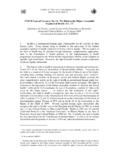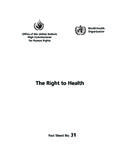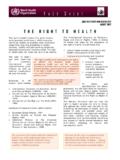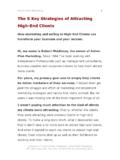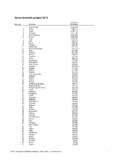Transcription of Impact Assessments, Poverty and Human Rights: A Case ... - …
1 1 Health and Human rights Working Paper Series No 6 Impact Assessments, Poverty and Human rights : A Case Study Using The Right to the highest Attainable Standard of Health By Professor Paul Hunt United Nations Special Rapporteur on the right of everyone to the highest attainable standard ofphysical and mentalhealth and Gillian MacNaughton Senior Research Officer Human rights Centre, University of Essex Submitted to UNESCO 31 May 2006 This report contains the views of international experts, and does not necessarily represent the decisions or the stated policy of the World Health Table of Contents Page Executive Summary 4 I. Introduction 6 II. Impact Assessments 8 A. Definitions 8 B. Objectives 10 C. Added Value of Human rights 12 1.
2 Legal Obligations 12 2. Coherence 13 3. Effectiveness 14 III. A Human rights Approach 16 A. Human rights and Poverty Reduction 16 B. Three Case Studies on Human rights Impact assessment 18 1. NORAD Handbook in Human rights assessment 18 2. rights & Democracy Initiative on Human rights Impact assessment 20 3. HOM Health rights of Women assessment Instrument 22 4. Discussion of the Three Approaches 25 IV. A Case Study: Impact assessment and the Right to Health 27 A. Health and Poverty 27 B. The Right to the highest Attainable Standard ofHealth 27 C. Right to Health Framework for the Impact assessment 31 1. Seven General Principles for rights Based Impact Assessments 32 (1) Explicit Human rights Framework 33 (2) Progressive Realization 33 (3)Equality and Non Discrimination 33 (4) Participation 33 (5)Information 34 (6) Accountability 34 (7) Inter dependence of rights 34 2.
3 Six Steps for Integrating theRight to Health intoImpact Assessments 34 Step 1: Preliminary Check 36 Step 2: assessment Plan 37 Step 3:Information Collection 38 Step 4: rights Analysis 40 Step 5: Debate Options 42 Step 6: Decision and Evaluation 44 V. Conclusions and Follow Up to this Report 46 A. Special Rapporteur on the Right to Health 46 B. Other Suggestions for Follow up to this Report 47 C. Methodologies for Human rights Impact assessment 47 D. Case Studies on Integrating Human rights into Impact assessment 48 Tools for Incorporating Human rights in Impact assessment 48 F. Lobby for Human rights in Impact assessment 483 Bibliography 50 Annex 1 Step 1: Preliminary Checklist 54 Annex 2 Step 2: Time Table 55 Step 2: What is Human rights based Impact assessment ?
4 56 Step 2: What is the right to health? 57 Annex 3 Step 3: Guideline Questionnaire A 58 AAAQ Health Care Step 3: Guideline Questionnaire B 59 AAAQ Underlying Determinants of Health Step 3: Guideline Questionnaire C 60 Six Human rights Concepts for Health Care Step 3: Guideline Questionnaire D 62 Six Human rights Concepts for Underlying Determinants of Health Annex 4 Step 4: Guide to rights Analysis Health facilities, goods and services 64 Underlying determinants of health 654 Executive Summary In recent years, there has been a growing demand for governments to carry out Human rights Impact assessments prior to adopting and implementing policies, programmes and projects. To date, however, little work has been done to develop methodologies and tools to aid governments in undertaking Human rights Impact assessments.
5 The purpose of this project is to contribute to the development of such a methodology. UNESCO provided the funding for this project, and the United Nations Special Rapporteur on the right of everyone to the enjoyment of the highest attainable standard of health ( the right to the highest attainable standard of health or the right to health ) supervised the project and preparation of this report. This report emphasizes the role of Human rights Impact assessment in alleviating Poverty . Today, Poverty is understood to be not simply an economic but rather a multi dimensional condition, including features such as hunger, illiteracy, discrimination, vulnerability and social exclusion. This broader definition corresponds closely to a deprivation of Human rights such as the rights to food, education, equality, non discrimination and participation.
6 The link between Poverty and the right to the highest attainable standard of health is especially close. Ill health is both a cause and a consequence of Poverty : sick people are more likely to become poor and poor people are more vulnerable to disease and disability. Recognizing these links, this report uses the right to health as a case study to look at how Human rights Impact assessments can help governments generate policies that both realize Human rights and alleviate Poverty . Human rights Impact assessment is the process of predicting the potential consequences of a proposed policy, programme or project on the enjoyment of Human rights . The objective of the assessment is to inform decision makers and the people likely to be affected so that they can improve the proposal to reduce potential negative effects and increase positive ones.
7 Human rights Impact assessment is a relatively recent concept. However, other forms of Impact assessment such as environmental and social Impact assessments are now well established and routinely undertaken in many countries to evaluate proposed policies, programmes and projects. Similarly, proposed policies, programmes and projects should be assessed for their Impact on Human rights prior to being adopted and implemented. This report reviews and then draws key criteria from three pioneering Human rights Impact assessment initiatives: (1) the NORAD Handbook in Human rights assessment , (2) the rights & Democracy Initiative on Human rights Impact assessment , and (3) the HOM Health rights of Women assessment Instrument.
8 We focus specifically on the obligation of governments to undertake Impact assessments in order to comply with their obligation to progressively realize Human rights and, accordingly, propose a methodology specifically suited to government assessments. The methodology is also intended to assess proposed policies it does not consider Impact assessments for programmes or projects, nor evaluations of policies that have already been implemented. We recognize that developing such a methodology is a complicated undertaking and will require much more work and debate. The approach presented in this report is intended as a modest contribution to the discussion on Human rights and Impact assessment , and we will welcome comments on this In designing a methodology for Impact assessments, there are at least two distinct approaches.
9 The first approach is to develop a self standing methodology for Human rights Impact assessments just as has been done for environmental and social Impact assessments. The other approach is to develop a methodology for integrating Human rights into other types of Impact assessments. This report proposes the second approach, consistent with mainstreaming Human rights into all government processes. The integration of Human rights into existing Impact assessments will require interdisciplinary collaboration between Human rights professionals, experts in various types of Impact assessment , and others. This study begins this process by contributing some Human rights considerations and frameworks and by outlining a methodology.
10 The report presents a methodology in two parts. The first part presents seven general principles for performing a rights based Impact assessment . These are (1) use an explicit Human rights framework, (2) aim for progressive realization of Human rights , (3) promote equality and non discrimination in process and policy, (4) ensure meaningful participation by all stakeholders, (5) provide information and protect the right to freely express ideas, (6) establish mechanisms to hold the State accountable, and (7) recognize the inter dependence of all Human rights . The second part of the methodology proposes six steps for integrating the right to health, as a starting point for integrating all Human rights , into existing Impact assessments.










